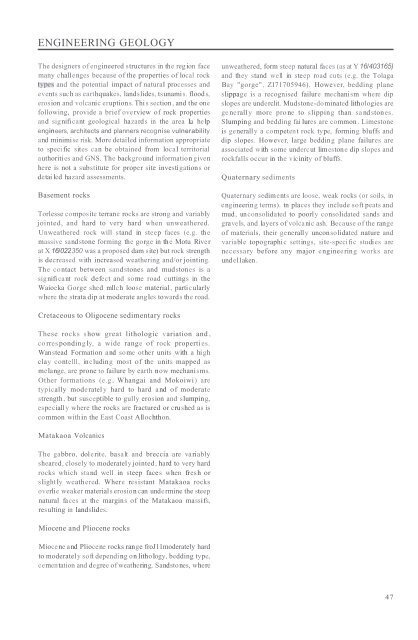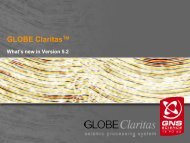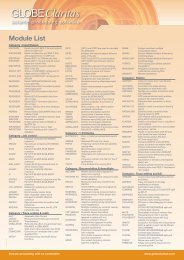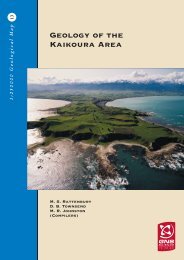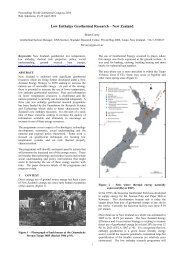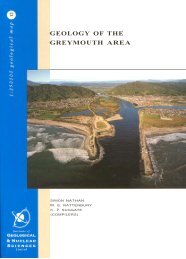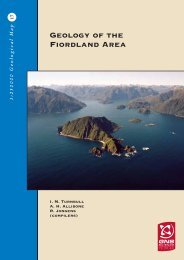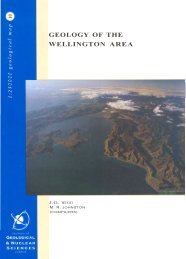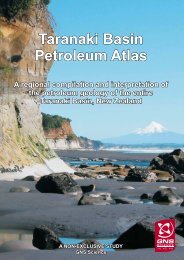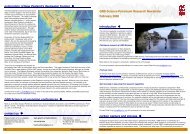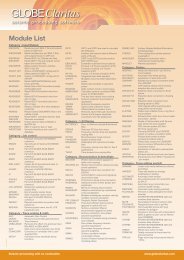ENGINEERING <strong>GEOLOGY</strong>The designers ofengineered structures in the reg ion facemany challenges because of the properties of local rocktypes and the potential impact of natural processes andevents such as earthquakes, landslides, tsunamis. floods,erosion and volcanic eruptions. This section , and the onefollowing, provide a brief overview of rock propertiesand significant geological hazards in the area La helpengineers, architects and planners recognise vulnerabilityand minimise risk. More detailed information appropriateto specific sites can be obtained from local territorialauthorities and <strong>GNS</strong>. The background information givenhere is not a substitute for proper site investigations ordetai led hazard assessments.Basement rocksTorlesse composite terrane rocks are strong and variablyjointed, and hard to very hard when unweathered.Unweathered rock will stand in steep faces (e.g. themassive sandstone forming the gorge in the Motu Riverat X 16/022350 was a proposed dam site) but rock strengthis decreased with increased weathering and/or jointing.The contact between sandstones and mudstones is asignifi cant rock defect and some road cuttings in theWaioeka Gorge shed mllch loose material, particularlywhere the strata dip at moderate angles towards the road.unweathered, form steep natural faces (as at Y 16/403165)and they stand well in steep road cuts (e.g. the TolagaBay "gorge", ZI71705946). However, bedding planeslippage is a recognised failure mechanism where dipslopes are underclit. Mudstone-dominated lithologies aregenerall y more prone to slipping than sand stones.Slumping and bedding fai lures are common. Limestoneis generally a competent rock type, forming bluffs anddip slopes. However, large bedding plane failures areassociated with some undercut limestone dip slopes androckfalls occur in the vicinity of bluffs.Quaternary sedimentsQuaternary sediments are loose, weak rocks (or soils, inengineering terms). tn places they include soft peats andmud, unconsolidated to poorly consolidated sands andgravels, and layers of volcanic ash. Because of the rangeof materials, their generally unconsolidated nature andvariable topographic settings, site-speci fi c studies arenecessary before any major engineering works areundel1aken .Cretaceous to Oligocene sedimentary rocksThese rocks show great lithologic variation and,corresponding ly, a wide range of rock properties.Wanstead Formation and some other units with a highclay conte l1l, including most of the units mapped asmelange, are prone to failure by earth now mechanisms.Other formations (e.g. Whangai and Mokoiwi) aretypically moderately hard to hard and of moderatestrength, but susceptible to gully erosion and slumping,especiall y where the rocks are fractured or crushed as iscommon within the East Coast Allochthon.Matakaoa VolcanicsThe gabbro, dolerite, basalt and breccia are variablysheared, closely to moderately jointed, hard to very hardrocks which stand well in steep faces when fresh orslightly weathered. Where resistant Matakaoa rocksoverlie weaker materials erosion can undermine the steepnatural faces at the margins of the Matakaoa massifs,resulting in landslides.Miocene and Pliocene rocksMiocene and Pliocene rocks range froJ11moderately hardto moderately soft depending on lithology, bedding type,cementation and degree of weathering. Sandstones, where47
GEOLOGICAL HAZARDSVolcanic activityThe Raukumara area is adjacent to the active TaupoVolcanic Zone (TVZ) where there have been manyeruptions before and since human occupation. Volcan.icash from TVZ eruptions has raUen over the Raukumaraarea in the past, and will do so agai n. The thickness ofash-fall at a particu lar site is influenced by factors suchas the volume of material ejected from the volcano, theforce of the eruption, the prevalent wind direction andthe distance from the volcano. The last major ign imbriticeruption in ew Zealand was from the Lake Taupo areaapproximately 1860 years ago; it deposited a maximumof SOO mm of ash near Ruakituri, and 100 mm of ashfurther east nearWhangara (Healy el al. 1964). Eruptionsof this size have an expecled frequency of 2S00-S000years (SCOll 1997). Smaller eruptions from Ruapehu,Egmonl, Taupo, Okataina orWhite Island are much morcfrequent.The area ofthe Raukumara map is likely to receive minorfalls of volcanic ash every 20-S0 years (Scott 1997). Theimpact wil l vary depending on the thickness. Even smalleru ptions could have signi fica nt effects. Fall ing ash isnot toxic but it acts as an irritant, affecting eyes andthroats. Casualties can result from secondary effects suchas roof collapses. Services and facili ties likely to beaffected are electricity supply, telecommunications, watersupply, waste-water, bui ldings and transportation (ai r,road. rail, sea). Pastoral farming, cropping andhorticulture will also be affected to varying degrees.ErosionRaukumara Peninsula is risi ng in response to deformationassociated with subduction processes at the boundarybetween theAustralian and Pacific plates; the rate of up liftis variable, ra ngi ng up to about 4 mm/year (ata el at.1992). The uplift is counterbalanced by natural erosionprocesses as streams and ri vers remove a vast amount ofdetritus to the sea. However, the influence of man hasaccelerated erosion processes; for example, the removalor substantial modification of the native vegetation coverhas created major land use problems. Erosion isrecognised as a key problem facing the East Coast region(e.g. Taylor 1970). The Mangatu area in the headwatersof the Waipaoa River provided a textbook case study ofrapid hillside erosion, gullying and stream aggradationfollowing the conversion of native forest to pasture (Fig.33; Cumberland 1947; Allsop 1973; Hicks & Campbell1998; DeRose et al. 1998). Similar problems are presentelsewhere (e.g. the Tapuaeroa and Waikura val leys).Though the most obvious effects of erosion are in theheadwaters (the "critical headwate rs" of the TaylorReport) accelerated erosion also poses problems for thoseliving lower in the catchment on the gently slopingfloodplains, because the vast amount ofgravel. sand andmud added to the drainage systems increases the risk andheight of tlood events. Low-lying terrace land of highvalue for agriculture can be inundated by gravel, sandand mud, as occurred duri ng Cyclone Bola in 1988 (Fig.6; Si ngleton el al. 1989a, I989b; Page el al. 1999).Major influences on the susceptibili ty of land to erosioninclude the extent and type of vegetation cover, rain fa llcharacteristics and slope angle. Geological factors suchas rock type (O'Byrne 1967), tectonic uplift andearthquake shaking are also very important. Rockproperties with a major influence on erosion susceptibi lityinclude:grain size - sandstone is generally stronger thanmudstonedegree of cementation - rocks with high amountsof calcium carbonate (e.g. limestone) or silica arerelatively erosion-resistant (see Pearce el at. 1981 )induration - older rocks are generally harder thanyounger rocksc lay mi neral content - many mudstones containsmecti te clays and break down readily d uringwetting and drying cyclesfractu res - fractured rock has lower strength thanun fractured rockcrushing - cnlshed rock associated with major faultsand thrusts has low strengthorientation of bedding surfaces to the land surfaceweathering - degree and thickness of the zone ofweathering.Mudstones oflhe Mangatu Group, Mangatuna Formationand, to a lesser extent, Whangai Formation are the mosterosion-prone geological units in the area. Most rocks ofthe East Coast Allochthon are also eroding rapidly, themajor exception being the resistant Matakaoa Volcanics.Miocene and Pliocene mudstones are extensively erodedin some ca t.chments. Pro t.ecti ve planting of exotic forestsstarted al Mangatu in 1960 (Gage & Black 1979) andwas later extended to cover other rapidly eroding areas.Reafforestation has substant ially reduced the rates oferosion and stream aggradation (DeRose 1996).Slope instability and landslidesSlope instability, often resulting in landslides. earth tlowsand surface creep, is a major problem for roads. railways.bui ldings and other structures, particularly in areas ofweak orclosely fractured rock. Rocks susceptible to slopefailure underlie much of the hill country southeast of thecrest of the Raukumara Range. from Cape Ru naway toWai roa. The extent and type oferosion and slope failureare highl y variable, as is soil development. Shall owseatedsoil slips are common on steep topography and in48


